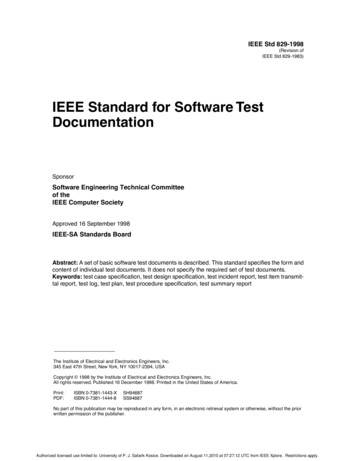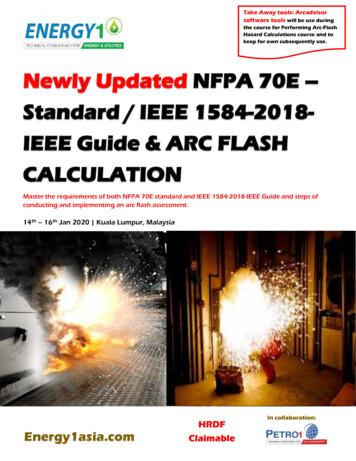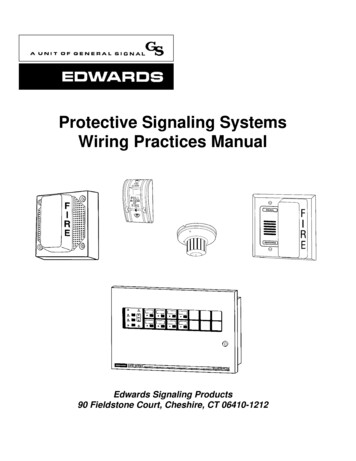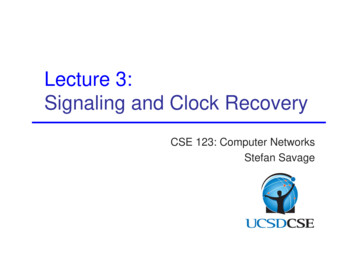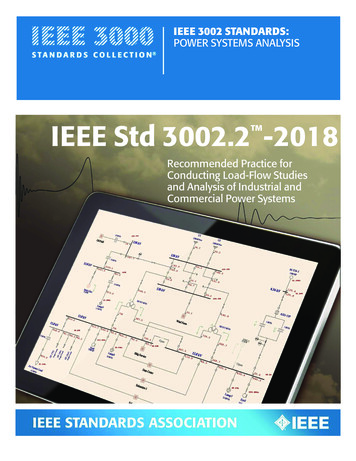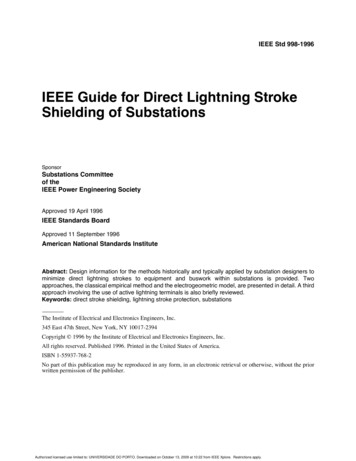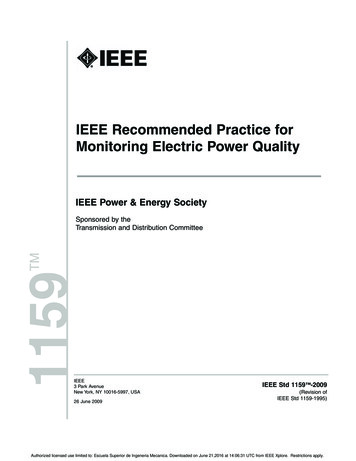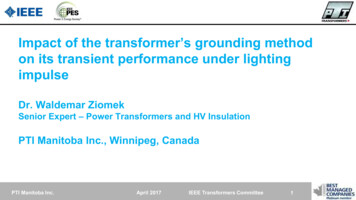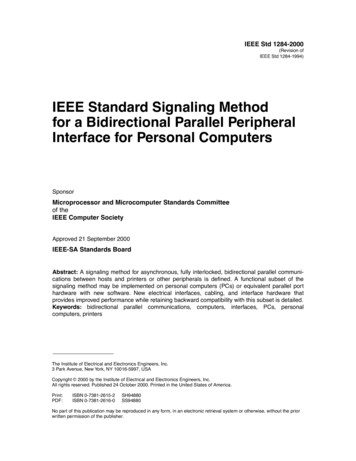
Transcription
IEEE Std 1284-2000(Revision ofIEEE Std 1284-1994)IEEE Standard Signaling Methodfor a Bidirectional Parallel PeripheralInterface for Personal ComputersSponsorMicroprocessor and Microcomputer Standards Committeeof theIEEE Computer SocietyApproved 21 September 2000IEEE-SA Standards BoardAbstract: A signaling method for asynchronous, fully interlocked, bidirectional parallel communications between hosts and printers or other peripherals is defined. A functional subset of thesignaling method may be implemented on personal computers (PCs) or equivalent parallel porthardware with new software. New electrical interfaces, cabling, and interface hardware thatprovides improved performance while retaining backward compatibility with this subset is detailed.Keywords: bidirectional parallel communications, computers, interfaces, PCs, personalcomputers, printersThe Institute of Electrical and Electronics Engineers, Inc.3 Park Avenue, New York, NY 10016-5997, USACopyright 2000 by the Institute of Electrical and Electronics Engineers, Inc.All rights reserved. Published 24 October 2000. Printed in the United States of America.Print:PDF:ISBN 0-7381-2615-2ISBN 0-7381-2616-0SH94880SS94880No part of this publication may be reproduced in any form, in an electronic retrieval system or otherwise, without the priorwritten permission of the publisher.
IEEE Standards documents are developed within the IEEE Societies and the Standards Coordinating Committees of the IEEE Standards Association (IEEE-SA) Standards Board. Members of the committees servevoluntarily and without compensation. They are not necessarily members of the Institute. The standardsdeveloped within IEEE represent a consensus of the broad expertise on the subject within the Institute aswell as those activities outside of IEEE that have expressed an interest in participating in the development ofthe standard.Use of an IEEE Standard is wholly voluntary. The existence of an IEEE Standard does not imply that thereare no other ways to produce, test, measure, purchase, market, or provide other goods and services related tothe scope of the IEEE Standard. Furthermore, the viewpoint expressed at the time a standard is approved andissued is subject to change brought about through developments in the state of the art and commentsreceived from users of the standard. Every IEEE Standard is subjected to review at least every five years forrevision or reaffirmation. When a document is more than five years old and has not been reaffirmed, it is reasonable to conclude that its contents, although still of some value, do not wholly reflect the present state ofthe art. Users are cautioned to check to determine that they have the latest edition of any IEEE Standard.Comments for revision of IEEE Standards are welcome from any interested party, regardless of membershipaffiliation with IEEE. Suggestions for changes in documents should be in the form of a proposed change oftext, together with appropriate supporting comments.Interpretations: Occasionally questions may arise regarding the meaning of portions of standards as theyrelate to specific applications. When the need for interpretations is brought to the attention of IEEE, theInstitute will initiate action to prepare appropriate responses. Since IEEE Standards represent a consensus ofall concerned interests, it is important to ensure that any interpretation has also received the concurrence of abalance of interests. For this reason, IEEE and the members of its societies and Standards CoordinatingCommittees are not able to provide an instant response to interpretation requests except in those cases wherethe matter has previously received formal consideration.Comments on standards and requests for interpretations should be addressed to:Secretary, IEEE-SA Standards Board445 Hoes LaneP.O. Box 1331Piscataway, NJ 08855-1331USANote: Attention is called to the possibility that implementation of this standard mayrequire use of subject matter covered by patent rights. By publication of this standard,no position is taken with respect to the existence or validity of any patent rights inconnection therewith. The IEEE shall not be responsible for identifying patents forwhich a license may be required by an IEEE standard or for conducting inquiries intothe legal validity or scope of those patents that are brought to its attention.IEEE is the sole entity that may authorize the use of certification marks, trademarks, or other designations toindicate compliance with the materials set forth herein.Authorization to photocopy portions of any individual standard for internal or personal use is granted by theInstitute of Electrical and Electronics Engineers, Inc., provided that the appropriate fee is paid to CopyrightClearance Center. To arrange for payment of licensing fee, please contact Copyright Clearance Center, Customer Service, 222 Rosewood Drive, Danvers, MA 01923 USA; (978) 750-8400. Permission to photocopyportions of any individual standard for educational classroom use can also be obtained through the Copyright Clearance Center.
Introduction(This introduction is not a part of IEEE Std 1284-2000, IEEE Standard Signaling Method for a Bidirectional ParallelPeripheral Interface for Personal Computers.)This standard was formally started as an IEEE effort in January 1992, but without the advance work done bya loose alliance of printer manufacturers and printer software developers called the Network PrintingAlliance, this standard would not be possible.The following lists the key contributors to the revision of this standard:Forrest D. Wright, ChairLarry Stein, SecretaryLance Spaulding, EditorDarrell CoxLee FarrellRobert GrossLaurie LassloHideki MorozumiBill MynttiFumio NagasakaDavid RoachBill RussellGreg ShueJerry ThrasherRick Vander WegenCraig WhittleThe following members of the balloting committee voted on this standard:Steven R. BardLon CanadayKeith ChowJames R. DavisSourav K. DuttaEdwin Vivian El-KarehLee FarrellThomas M. KuriharaCopyright 2000 IEEE. All rights reserved.Joseph R. MarshallGene E. MilliganRobert MortonsonKlaus-Dieter MuellerAtsushi NakamuraRoman OrzolGary S. RobinsonDavid RockwellJaideep RoyThomas J. SchaalAkihiro ShimuraLarry SteinJoseph TardoMichael G. ThompsonForrest D. WrightOren Yueniii
When the IEEE-SA Standards Board approved this standard on 21 September 2000, it had the followingmembership:Donald N. Heirman, ChairJames T. Carlo, Vice ChairJudith Gorman, SecretarySatish K. AggarwalMark D. BowmanGary R. EngmannHarold E. EpsteinH. Landis FloydJay Forster*Howard M. FrazierRuben D. GarzonJames W. MooreRobert F. MunznerRonald C. PetersenGerald H. PetersonJohn B. PoseyGary S. RobinsonAkio TojoDonald W. ZipseJames H. GurneyRichard J. HollemanLowell G. JohnsonRobert J. KennellyJoseph L. Koepfinger*Peter H. LipsL. Bruce McClungDaleep C. Mohla*Member EmeritusAlso included is the following nonvoting IEEE-SA Standards Board liaison:Alan Cookson, NIST RepresentativeDonald R. Volzka, TAB RepresentativeGreg KohnIEEE Standards Project EditorivCopyright 2000 IEEE. All rights reserved.
Contents1.Overview. 11.1 Scope. 11.2 Purpose. 12.References. 23.Definitions. 23.1 General terminology . 23.2 Communication modes . 43.3 Operating phases. 44.Features and compliance. 74.14.24.34.44.55.Interface overview . 7Features . 7Device compatibility criteria. 7Device compliance criteria . 8Cable compliance criteria . 9Interface signals . 105.1 HostClk/nWrite (nStrobe): host driven. 105.2 AD1.AD8 (Data1.Data8) . 105.3 PtrClk/PeriphClk/Intr (nAck): peripheral driven . 105.4 PtrBusy/PeriphAck/nWait (busy): peripheral driven. 115.5 AckDataReq/nAckReverse (PError): peripheral driven . 115.6 Xflag (Select): peripheral driven . 115.7 HostBusy/HostAck/nDStrb (nAutoFd): host driven. 125.8 Peripheral Logic High: peripheral driven . 125.9 nReverseRequest (nInit): host driven. 125.10 nDataAvail/nPeriphRequest (nFault): peripheral driven . 135.11 1284 Active/nAStrb (nSelectIn): host driven . 135.12 Host Logic High: host driven. 136.Interface concepts . 146.1 Link level and data level separation. 146.2 IEEE 1284 communication options . 146.3 Nibble Mode/Byte Mode transfer . 156.4 Host-initiated transfers. 156.5 Peripheral-initiated transfers. 156.6 Multiple byte transfers . 156.7 Interface errors . 156.8 Peripheral error resolution . 166.9 ECP Mode command/data . 166.10 EPP Mode addressing . 176.11 Device identification. 18Copyright 2000 IEEE. All rights reserved.v
7.Interface operation . 197.17.27.37.47.57.67.77.88.Power-On . 19Initialization . 19Compatibility Mode . 19Negotiation. 20Peripheral-to-host transfer modes . 28Device ID . 52Termination. 53Collisions . 53Mechanical and electrical interface .
PDF: ISBN 0-7381-2616-0 SS94880 No part of this publication may be reproduced in any form, in an electronic retrieval system or otherwise, without the prior written permission of the publisher. IEEE Std 1284-2000 (Revision of IEEE Std 1284-1994) IEEE Standard Signaling Method for a Bidirectional Parallel Peripheral Interface for Personal Computers Sponsor Microprocessor and Microcomputer .


